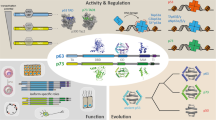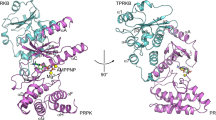Abstract
Recently, it has been demonstrated that a single point mutation is responsible for the acquisition of transforming properties by the EJ and T24 human bladder carcinoma gene1–3. The point mutation consists of the conversion of guanine into thymine, which results in the replacement of a glycine by a valine at position 12 of the p21 protein encoded by the EJ and T24 genes. Sequence data of retroviral analogues of the p21 protein1–5 also indicate the importance for a glycine residue at position 12 in normal p21. Comparison of the sequence of the 37 N-terminal residues of the normal human p21 protein with the sequence of the dinucleotide-binding βαβ unit in a group of structurally related enzymes, suggests that these residues of p21 fold into a very similar unit which is also involved in binding a nucleotide. We present here a three-dimensional model of the p21 βαβ unit which explains directly why glycine at position 12 cannot be replaced by another residue without altering the nucleotide-binding properties of p21.
This is a preview of subscription content, access via your institution
Access options
Subscribe to this journal
Receive 51 print issues and online access
$199.00 per year
only $3.90 per issue
Buy this article
- Purchase on SpringerLink
- Instant access to full article PDF
Prices may be subject to local taxes which are calculated during checkout
Similar content being viewed by others
References
Tabin, C. J. et al. Nature 300, 143–149 (1982).
Reddy, E. P., Reynolds, R. K., Santos, E. & Barbacid, M. Nature 300, 149–152 (1982).
Taparowsky, E. et al. Nature 300, 762–765 (1982).
Dhar, R. et al. Science 217, 934–936 (1982).
Tsuchida, N., Ryder, T. & Ohtsubo, E. Science 217, 937–939 (1982).
Scolnick, E. M., Papageorge, A. G. & Shih, T. Y. Proc. natn. Acad. sci. U.S.A. 76, 5355–5359 (1979).
Shih, T. Y., Papageorge, A. G., Stokes, P. E., Weeks, M. O. & Scolnick, E. M. Nature 287, 686–691 (1980).
Papageorge, A., Lowy, D. & Scolnick, E. M. J. Virol. 44, 509–519 (1982).
Bedarkar, S., Turnell, W. G., Blundell, T. L. & Schwabe, C. Nature 270, 449–451 (1977).
Isaacs, N. et al. Nature 271, 278–281 (1978).
Blundell, T. L., Bedarkar, S., Rinderknecht, E. & Humbel, R. E. Proc. natn. Acad. sci. U.S.A. 75, 180–184 (1978).
Ohlsson, I., Nordström, B. & Brändén, C. I. J. molec. Biol. 89, 339–354 (1974).
Rossmann, M. G., Moras, D. & Olsen, K. W. Nature 250, 194–199 (1974).
Schulz, G. E., Schirmer, R. H. & Pai, E. F. J. molec. Biol. 160, 287–308 (1982).
Hofsteenge, J. et al. Eur. J. Biochem. 113, 141–150 (1980).
Hol, W. G. J., Van Duijnen, P., & Berendsen, H. J. C. Nature 273, 443–446 (1978).
Brandenburg, N. P., Dempsey, S., Dijkstra, B. W., Lijk, L. J. & Hol, W. G. J. J. appl. Crystallogr. 14, 274–279 (1981).
Wierenga, R. K., De Jong, R. J., Kalk, K. H., Hol, W. G. J. & Drenth, J. J. molec. Biol. 131, 55–73 (1979).
Weijer, W. J., Hofsteenge, J., Vereijken, J. M., Jekel, P. A. & Beinbema, J. J. Biochim. Biophys. Acta 704, 385–388 (1982).
Müller, F. & Van Berkel, W. J. H. Eur.J. Biochem. 128, 21–27 (1982).
Samama, J. P., Zeppezauer, E., Biellmann, J. F. & Bränden, C. I. Eur. J. Biochem. 81, 403–409 (1977).
Cooper, G. M. Science 218, 801–806 (1982).
DeFeo, D. et al. Proc. natn. Acad. Sci. U.S.A. 78, 3328–3332 (1981).
Chang, E. H., Furth, M. E., Scolnick, E. M. & Lowy, D. R. Nature 297, 479–483 (1982).
Gay, N. J. & Walker, J. E. Nature 301, 262–264 (1983).
Walker, J. E., Saraste, M., Runswick, M. J. & Gay, N. J. EMBO J. 1, 945–951 (1982).
Pai, E. F., Sachsenheimer, W., Schirmer, R. H. & Schulz, G. E. J. molec. Biol. 114, 37–45 (1977).
White, J. L. et al. J. molec. Biol. 102, 759–779 (1976).
Eklund, H. et al. J. molec. Biol. 146, 561–587 (1981).
Moras, D. et al. J. biol. Chem. 250, 9137–9162 (1975).
Krauth-Sieghel, R. L. et al. Eur. J. Biochem. 121, 259–267 (1982).
Taylor, S. S. J. biol. Chem. 252, 1799–1806 (1977).
Jörnvall, H. Eur. J. Biochem. 16, 25–40 (1970).
Davidson, B. E., Sajgó, M., Noller, H. F. & Harris, J. I. Nature 216, 1181–1185 (1967).
Samama, J. P., Wrixon, A. D. & Biellmann, J. F. Eur. J. Biochem. 118, 479–486 (1981).
Author information
Authors and Affiliations
Rights and permissions
About this article
Cite this article
Wierenga, R., Hol, W. Predicted nucleotide-binding properties of p21 protein and its cancer-associated variant. Nature 302, 842–844 (1983). https://doi.org/10.1038/302842a0
Received:
Accepted:
Issue Date:
DOI: https://doi.org/10.1038/302842a0
This article is cited by
-
Inorganic polyphosphate induces accelerated tube formation of HUVEC endothelial cells
Cellular and Molecular Life Sciences (2018)
-
Measure transcript integrity using RNA-seq data
BMC Bioinformatics (2016)
-
Acetophenone reductase with extreme stability against a high concentration of organic compounds or an elevated temperature
Applied Microbiology and Biotechnology (2013)
-
Membrane guanylate cyclase is a beautiful signal transduction machine: overview
Molecular and Cellular Biochemistry (2010)
-
Atrial natriuretic factor-receptor guanylate cyclase signal transduction mechanism
Molecular and Cellular Biochemistry (2010)



